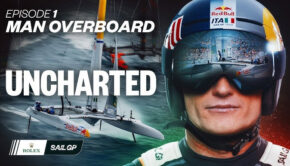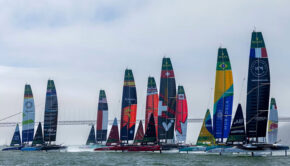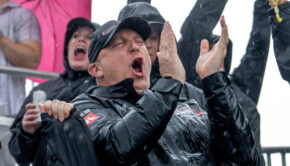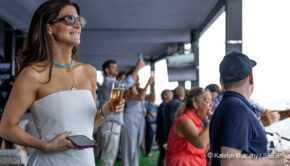SailGP: Expediting the learning process
Published on May 6th, 2019
Improving through the inaugural SailGP season is vital, but with limited practice time on the F50s, performance data from all the boats is being used to expedite the learning process. John Bonds attended a technology presentation which offered insight into the full-foiling, wing-powered catamaran the six national teams were seeking to harness. Here’s his report:
What it’s like foiling a F50:
“It’s like balancing a broomstick on your fingertip,” said SailGP Technical Director Mike Drummond, when describing sailing a F50 catamaran up on its foils. “Except this broomstick on your finger is actually only a few inches long, and has another full-length broomstick, with a broom on the upper end of it, way up in the air, balanced on top of it.
“But it’s not exactly on your fingertip; it’s on the fingertip of your friend, standing right next to you, and you are telling him how to move his finger to keep it balanced there.”
To keep these boats sailing on their foils, the sailors are constantly adjusting the angles of the foils and sails to achieve and maintain a most opportune ‘ride height’ of the leeward hull above the water.
Very small changes to the bow-up attitude make a tremendous amount of difference: Russell Coutts indicated during a boat tour that a difference of 50cm in ride height when foiling can mean a difference of two to four knots of boat speed. Too low, and your hull slaps the water and that’s very slow. Too high, and the water foil will cavitate (the water around the foil breaks down / boils / evaporates), and you crash back down into the water while going 25 mph.
How they sail these beasts:
“We sail these boats as you sail most boats, with a seat-of-the pants feeling, combined with the data,” said US SailGP Team crew Hans Henken, who is a Stanford University graduate with a master’s degree in aeronautical and astronautical engineering.
“We can certainly and dramatically feel when a boat ‘releases’ (presumably from the water and transitioning into a foiling mode), and this is very positive feedback! We use the data to quantify what we did in terms of trimming, moding, and sailing the boat, and to replicate when we have been able to do it particularly well.
“Pitch and ride height are the comms between the flight controller and the helmsman. More bow down attitude on the boat provides more speed. Our wing trimmer Riley Gibbs changes the attitude and twist of the wing in order to give us the power we want, when we want it.”
Getting and keeping these things flying is tremendously hard work, and it is difficult. Data has helped these sailors to better learn and understand their flying machines.
The boats are highly instrumented, with1200 sensors onboard each vessel. Oracle is helping SailGP to collect, display, transmit, store, and analyze 20 MB of data from every race boat, per 15-minute race. With 1000 channels of information from sensors onboard, and with some channels operating at 50 hz (readings per second), it’s a significant data stream. From it, they are inferring the behaviors of the boat.
How the data flows:
SailGP proprietary IP is layered atop an Oracle open platform. Oracle intends that model to be replicated for additional sports applications. The SailGP electronics team build some of their own gear, using some conventional marine electronics sensors (from B&G and others), feeding real-time info to on-board displays for vital boat performance and control information.
Every race boat has individual SIM cards, hubs, and their own bandwidth, and their performance data is relayed in real-time via telemetry across a low-latency, custom-built LTE (4G wireless) network built with multiple antennas around and upon the waterfront race area.
The data (and audio, and video) collected on each race boat flows into a popup data center and into the cloud, at 200 ms. Live video screens onshore, on coach boats, course marshal boats and other displays are powered from a 100 ms from SailGP in London. All of this info mashes up into the SailGP app.
How the data gets used after sailing:
Data gets loaded into autonomous data platforms that include AI. Oracle engineers can set up the data they want to look at, like a Spotify playlist. Teams have hired data analysts to interpret and help teams to learn from data collected and uploaded from sailing sessions and races to better inform performance.
Before San Francisco, SailGP did not have an adequate dataset to fully analyze the performance of these newly-configured boats; conditions at the Sydney event had light breezes, and they may not have had the opportunity to collect enough race-quality data in heavier air conditions.
That will not be the case after San Francisco; the dataset will be more robust, well-developed and useful, and can be compared meaningfully against designer’s polars and targets.
Data is shared and open to all teams:
Unlike most other types of sailing, each boat gets to look at data from all the other boats, in real time, and during post-race analysis. This is in marked contrast to the America’s Cup, and almost all other sailing.
By using stored performance data, and comparing their sailing efforts to those of the teams who made their boats perform better, the playing field gets leveled.
By the support team analyzing the information, this real-time feedback is enabling improvement during the day while out training and racing, building significantly upon the effectiveness of traditional post-race analysis. In conventional sailing, this is prohibited by the racing rules, which prohibit communications or access to information that is not specifically and freely available to all competitors.
In the future, new teams will be able to rapidly get up to speed by learning the boats virtually at first, with stored data, and then going sailing and trying to emulate bench-marked performance achieved by experienced and well-practiced teams.
The data being collected is leading directly to design improvements, including larger wings for lighter venues, and possibly different rudders. The boats will remain one-design but will evolve. Specific suggestions by individual teams are considered for applicability for inclusion in design mods to all boats.
There’s a lot more technological development continuing upon the racing boats, and while the data being used for boat technology development and ability to fly them is the most interesting to some of us, SailGP is focused on tech development well beyond the race boats.
“We are optimizing everything in conjunction…boat tech, broadcast tech, fan experience, and it’s a lot!” Drummond noted.”
Super-detailed post-session analysis:
After each sailing day, the post-race debrief with the sailors and support team goes through race videos, audio, hand written notes, audio notes, and the post-race debrief generates lots of questions from the sailors who, during the race, had their hands full just trying to keep the boat flying. When the action is over, they want to know how to fly better.
Boat sensor data, coupled with onboard video, onboard audio, and all boat’s GPS positions displayed in the most appropriate ways enable immersive re-creation of a session or race for analysis. More details provide better data analysis, and a more realistic and accurate recreation may enable noticing small things that might have had unanticipated or surprisingly large inputs into a process – whether it might be a crash or a particularly nice liftoff, tack, or gybe.
Comparing actual performance achieved in a race to theoretical models, benchmarked best behaviors, speeds and angles, and to performance of other teams sailing in the same conditions, in that same race, enables detailed and quick learning opportunities. Teams can look at all of the settings they used onboard for sail and foil controls, compare them to the settings used by other boats in that race and others, and rapidly learn to do things better.
Many F50 settings are automated within control buttons used on the systems. Super-detailed data logging enables post-race analysis of exactly when buttons were pressed, in what sequence, and by whom, to minutely examine what works, and what doesn’t work, as these talented athletes learn to fly these sailing machines.
With continuous improvement of systems, sails, foils, controls, and the sequencing of what they do with all of them, the sailors are going to soon learn to balance their broomsticks and foil all the way around the race courses. A race with multiple boats that never slow below 19 knots will be a whole new and exciting kind of simultaneous and competitive broomstick-balancing.
—————–
Contributing on the panel were Mike Drummond, Technical Director, SailGP; Edwin Upson, GVP, Enterprise Cloud Architects, Oracle; Warren Jones, Director of Technology, SailGP; Hans Henken, Flight Controller US SailGP Team; Tom Burnham, Coach, US SailGP Team; and Phil Crane, Data Analyst, US SailGP Team.
SailGP details – Team rosters – Results – Where to watch – Facebook
ABOUT SAILGP:
Established in 2018 and headquartered in London and San Francisco, SailGP seeks to be an annual, global sports league featuring fan-centric, inshore racing in some of the iconic harbors around the globe and culminates with a $1 million winner-takes-all match race. Rival national teams from Australia, China, France, Great Britain, Japan, and the United States battle it out in identical wing-powered, foiling F50 catamarans, engineered to exceed 50 knots.
2019 Schedule
Sydney, Australia (February 15-16)
San Francisco, USA (May 4-5)
New York, USA (June 21-22)
Cowes, UK (August 10-11)
Marseille, France (September 20-22)









 We’ll keep your information safe.
We’ll keep your information safe.